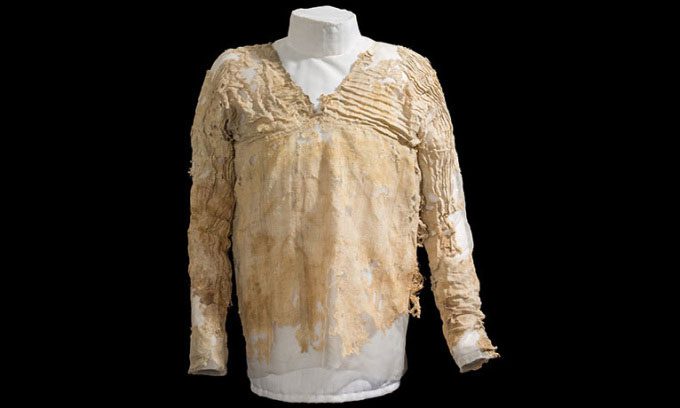Clothing not only protects humans but also carries spiritual significance; however, experts are still unsure about the exact time clothing first appeared.
It is challenging to determine precisely when modern humans (Homo sapiens) began wearing clothes due to a lack of archaeological evidence for a definitive answer. The oldest direct evidence available to experts is the Tarkhan Dress, a V-neck linen shirt discovered by Egyptologist Flinders Petrie in a tomb from the First Dynasty of ancient Egypt at the Tarkhan cemetery. Carbon dating reveals that the garment was produced around 3482 – 3102 BC.

Tarkhan Dress, a shirt produced in ancient Egypt over 5,000 years ago. (Photo: Petrie Museum of Egyptian Archaeology)
Humans may have worn clothing even before this time, but to date, archaeologists have not found any garments older than the Tarkhan Dress. This is not surprising because, unlike today, where many outfits are made from synthetic fibers that are not biodegradable, ancient clothing was made from plant and animal sources that easily decompose, such as wool or linen. The longevity of the Tarkhan Dress may be attributed to its preservation in an extremely dry environment, which hindered deterioration.
The Tarkhan Dress is the oldest nearly intact garment ever discovered, but it is not the earliest evidence of textiles. For instance, archaeologists have found fragments of plant-based textiles in the ancient settlement of Çatalhöyük in Turkey, dating back approximately 8,500 years. This suggests that humans may have been producing and wearing clothing at that time.
Another much older piece of evidence was found in the Dzudzuana cave in Georgia, Turkey, consisting of flax fibers. Some of these fibers were twisted and dyed using natural pigments. Researchers believe this could be evidence of clothing making. Notably, these fibers date back to around 30,000 years, marking a significant leap in the timeline of clothing’s origin.
Scientists are also using more specialized methods to trace the origins of clothing even further back in time: they are studying lice. There are two types of lice that live on humans: head lice and body lice. The latter also inhabit clothing, so scientists believe that determining when they appeared could provide indirect evidence of when humans began wearing clothes.
Researchers have compared the DNA of head and body lice to ascertain when the latter diverged. A recent estimate suggests that body lice likely separated from head lice around 83,000 – 170,000 years ago. However, this is only a preliminary estimate. Body lice would require time to adapt, indicating that clothing may have originated slightly before this period.
These are just some pieces of evidence regarding when modern humans began wearing clothing. Additionally, experts have discovered traces suggesting that Neanderthals may have also worn fur coats. However, the longer ago events occurred, the more difficult it becomes to find direct evidence. Therefore, it is likely that we may never know the exact moment clothing was invented.




















































